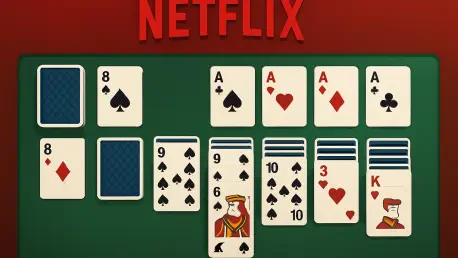Netflix has carved out a significant niche in the mobile gaming arena, offering subscribers access to over 100 titles at no additional cost, and the latest data reveals a surprising frontrunner that has captured players’ attention across the globe. Spanning from May 7th to August 12th, the playtime statistics published by Netflix shine a spotlight on user engagement trends within its gaming library. At the top of this ranking, determined by a points system similar to FlixPatrol’s methodology, sits Solitaire, a classic card game that has unexpectedly outpaced more modern or complex offerings. This revelation not only underscores the preferences of Netflix’s diverse audience but also hints at broader patterns in how mobile games are consumed on the platform. As the gaming landscape evolves, understanding what drives playtime and engagement offers valuable insight into the intersection of entertainment and technology.
Unveiling the Top Performers
Solitaire’s Unmatched Popularity
Solitaire, crafted by MobilityWare, has emerged as the undisputed leader among Netflix’s mobile games, securing an impressive 963 points and an average daily rank of 1.07 during the analyzed period. This classic card game, devoid of any Netflix-specific branding or unique tie-ins, mirrors versions found on other platforms like Apple Arcade, free from microtransactions. Its position at the pinnacle of the rankings speaks volumes about the appeal of simplicity and familiarity. For many users, Solitaire represents a low-stakes, accessible escape that requires minimal learning or commitment, making it a go-to choice across a wide demographic. This dominance suggests that Netflix’s audience, often characterized by a casual approach to entertainment, prioritizes ease over flashy innovation when it comes to mobile gaming.
The sustained success of Solitaire also points to a deeper trend within the platform’s ecosystem, where universal recognition plays a critical role in driving engagement. Unlike newer titles that may struggle with visibility, Solitaire benefits from being a household name, instantly recognizable to players of all ages. This inherent advantage allows it to maintain a consistent presence in daily playtime charts, overshadowing games that might offer more complex mechanics or thematic depth. Furthermore, its lack of reliance on promotional boosts or seasonal content releases indicates that intrinsic appeal, rather than external marketing, fuels its popularity. As Netflix continues to expand its gaming offerings, Solitaire’s reign highlights the enduring power of timeless, straightforward gameplay in capturing and retaining user interest.
Strength of Nostalgia and Depth in Other Titles
Following Solitaire, GTSan Andreas – The Definitive Edition claims second place with 852 points and an average rank of 2.22, showcasing the significant draw of nostalgic, well-known titles. This game, rooted in a franchise with a storied history, taps into a sense of familiarity and cultural resonance that connects with a broad swath of players. Its high ranking underscores how established intellectual property can cut through the noise of a crowded gaming catalog, offering a sense of comfort and reliability. For Netflix subscribers, engaging with a title like GTSan Andreas may evoke memories of past gaming experiences, reinforcing its staying power on the platform despite the availability of newer releases.
In the third and fourth spots, Football Manager Mobile 2024 with 743 points and Bloons TD 6 with 658 points reveal another facet of player preference—depth and replayability. These titles cater to users who seek more involved experiences, with mechanics that reward consistent engagement through progression systems and strategic challenges. Football Manager, for instance, appeals to sports enthusiasts with its detailed simulation, while Bloons TD 6 offers tower defense gameplay that encourages daily interaction. Their strong performance indicates that while casual games dominate, there exists a significant segment of Netflix’s audience craving complexity and long-term investment, balancing out the preference for quick, easy play seen in Solitaire’s success.
Broader Patterns in User Engagement
Accessibility as a Driving Force
A clear trend emerging from Netflix’s mobile gaming data is the overwhelming preference for accessible, low-barrier games that cater to a wide audience. Titles like Solitaire and Word Trails, which secured a spot in the top 10 with 508 points, exemplify this pattern with their intuitive mechanics and minimal learning curves. These games align perfectly with the profile of Netflix’s user base, often described as broad and somewhat passive in their consumption habits. For many subscribers, mobile gaming serves as a brief diversion rather than a dedicated hobby, making straightforward experiences far more appealing than those requiring significant time or skill investment. This gravitation toward simplicity reflects a desire for instant gratification and ease in an increasingly busy digital landscape.
Moreover, the success of casual games on Netflix’s platform suggests that the integration of gaming into a primarily streaming-focused service naturally favors titles that don’t demand deep engagement. Users accessing games through the same app they use for TV shows and movies are likely seeking quick, undemanding entertainment rather than immersive, time-intensive experiences. This dynamic creates an environment where games like Solitaire thrive, as they can be picked up and put down at a moment’s notice without disrupting daily routines. As Netflix continues to refine its gaming strategy, understanding this preference for accessibility will be crucial in curating a library that resonates with the majority of its subscribers while still offering variety.
Struggles of Newer Titles and IP Synergies
While established and casual games dominate playtime, newer releases and Netflix IP tie-ins face significant hurdles in achieving lasting engagement. A prime example is Squid Game: Unleashed, which peaked at fifth place with 517 points during promotional efforts linked to the show’s third season premiere but has since seen a decline in rankings. This temporary surge illustrates the potential of cross-promotion with Netflix’s film and TV catalog to drive short-term interest. However, the game’s inability to sustain its position highlights a critical challenge: without inherent replayability or ongoing updates, even strong IP connections struggle to maintain player attention over time. This pattern reveals the fragility of relying solely on thematic synergy for success.
Adding to this challenge is the broader issue of discoverability, as evidenced by the limited traction of new titles like Blood Line: A Rebel Moon Game, which failed to chart despite a beta phase. With only 15 of over 100 available games making the top lists during the data period, playtime remains heavily concentrated on a small subset of titles. Newer games often lack the marketing push or brand recognition needed to stand out in a saturated catalog, leaving them overshadowed by familiar favorites. This disparity suggests that Netflix must address visibility barriers if it hopes to diversify engagement across its gaming library. Without strategic interventions, the dominance of established titles may stifle the growth potential of fresh content, limiting the platform’s ability to innovate within the mobile gaming space.
Evolving Directions for Netflix Games
Moving Beyond Mobile Priorities
Under new leadership, Netflix Games appears to be undergoing a notable shift, with a reduced emphasis on mobile titles in favor of developing games for television and web platforms. This strategic pivot indicates a broader vision for integrating gaming more seamlessly into the overall Netflix experience, potentially reaching users on larger screens and through different interaction models. As a result, the frequency of new mobile game releases may taper off, a change that could solidify the current top rankings for games like Solitaire in the foreseeable future. This redirection reflects an acknowledgment that mobile gaming, while popular, may not be the sole avenue for expanding Netflix’s gaming footprint in a competitive market.
The implications of this shift extend to how resources are allocated within the company’s gaming division. With attention turning toward non-mobile platforms, the focus on updating or promoting existing mobile titles might diminish, potentially leading to a static landscape where only a handful of games continue to dominate playtime metrics. For subscribers accustomed to the current lineup, this could mean fewer surprises in the mobile gaming catalog, with familiar names maintaining their stronghold. However, it also raises questions about whether Netflix can balance innovation across different formats while ensuring that its mobile offerings remain relevant to a casual audience that values consistency and accessibility over frequent change.
Navigating Discoverability and Future Growth
Discoverability remains a persistent challenge within Netflix’s mobile gaming ecosystem, as seen in the underwhelming performance of newer titles like Blood Line: A Rebel Moon Game, which garnered minimal engagement despite its release. The data shows a stark reality: a mere fraction of the platform’s extensive game library captures significant playtime, pointing to a need for enhanced mechanisms to spotlight lesser-known titles. Without robust marketing or intuitive recommendation systems, many games risk fading into obscurity, unable to compete with the entrenched popularity of top-ranked entries. Addressing this issue could involve leveraging Netflix’s expertise in personalized content suggestions, adapting those algorithms to surface relevant games based on user behavior and preferences.
Looking ahead, the future of mobile gaming on Netflix will likely hinge on how the company reconciles its strategic shifts with the evident diversity in player preferences. While casual titles currently lead, the presence of more involved games like Football Manager Mobile 2024 in the top ranks suggests an audience segment eager for depth and progression. Balancing these dual interests—quick play versus sustained engagement—will be key to fostering growth. Reflecting on the period analyzed, it’s evident that Netflix made strides in understanding its gaming audience through transparent data sharing. Moving forward, leveraging those insights to refine curation and promotion strategies could ensure that both new and existing titles find their place, enriching the platform’s gaming ecosystem for all subscribers.









